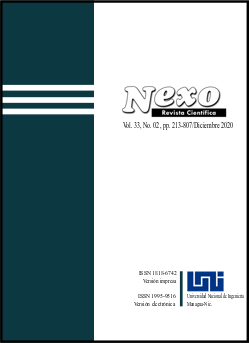Investigation of mineralization in copper-porphyry molybdenum using hydrothermal alternation in northwest region of Iran
DOI:
https://doi.org/10.5377/nexo.v33i02.10806Keywords:
Mineralization, Copper, Molybdenum, Hydrothermal TreatmentAbstract
Identification and determination of areas with mineral potential is one of the major and important applications of remote sensing in the field of mineral exploration. The aim of the present study was Identification of hydrothermal ultrason region using Landsat multispectral satellite imagery and hyperion hyperspectral imagery. To conduct this research, first the Advanced Space Borne thermal reflection radiometric data and the base metal mapping of the harvest were examined. Using principal component analysis using the key spectral change properties of key minerals, PC 2 enhanced the altered regions. Then we studied the MF spectral library and laboratory spectra of samples in the study area. In this study, two different methods, principal component analysis (PCA) and matched filter processing (MF), were compared and combined for mapping. In both methods, the key properties of changing the range of minerals in the study area were used. The results of the present study showed that from the top of the deposit to the bottom, the type of mineralization is gradually increasing. Chalcopyrite spraying gradually decreases from the depth of the deposit to the outer regions and vice versa, the amount of pyrite spraying increases. In Sungun, the main mineralization of copper in the second (main) stage of the activity of mineralized solutions has taken place, during which chalcopyrite has been extensively left in the form of vessels and sprays in rocks. Molybdenite is formed in a wide range of second stage mineralization processes in several successive phases. In the early processes, this mineral is sprayed and less in the form of veins and in later stages more in the form of veins. Thus, the copper-molybdenum porphyry deposit of Sungun Ahar, with a very high reserve of 7.1 billion tons and an average copper grade of 0.75 ٪ And molybdenite by-mineral in the early 80's will certainly be exploited among the largest copper mines in Iran.
Downloads
Downloads
Published
How to Cite
Issue
Section
License
Copyright (c) 2021 Array

This work is licensed under a Creative Commons Attribution 4.0 International License.
The authors who publish in Nexo Scientific Journal agree to the following terms:
- Authors retain the copyright and grant the journal the right of the first publication under the license Creative Commons Attribution License https://creativecommons.org/licenses/by/3.0/, which allows others to share the work with a recognition of the authorship of the work and the initial publication in Nexo Scientific Journal.
- Authors may separately establish additional agreements for the non-exclusive distribution of the version of the work published in the journal (for example, in an institutional repository or a book), with the recognition of the initial publication in Nexo Scientific Journal.
- Authors are allowed and encouraged to disseminate their works electronically (for example, in institutional repositories or in their own website) before and during the submission process, as it can lead to productive exchanges, as well as earlier and greater citation of published works.











